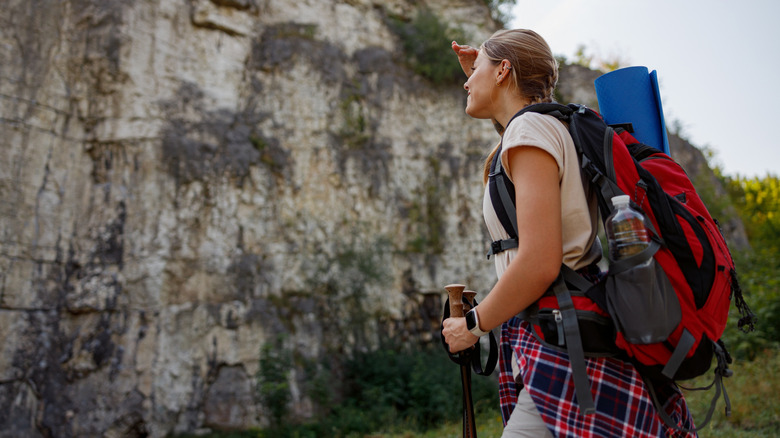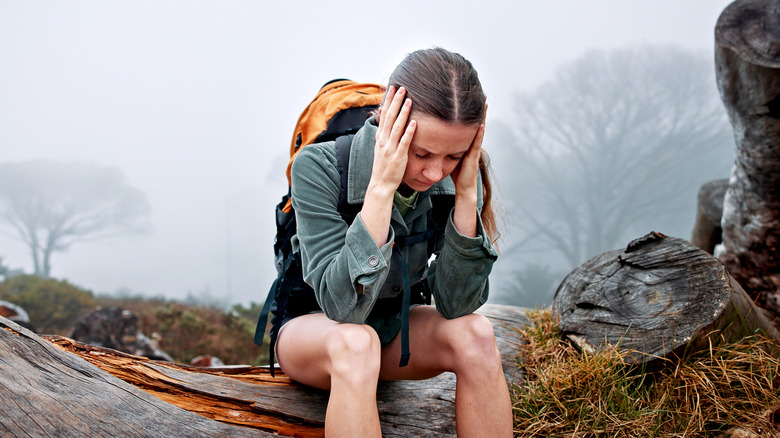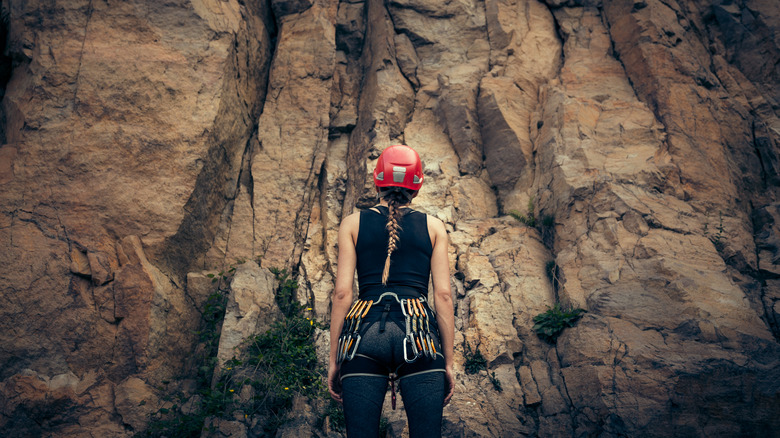What It Means To Get 'Cliffed Out' While Hiking And Why It's A Dangerous Position To Be In
Imagine finding yourself in a tight spot during a hike: You cannot go further, nor can you go back. You're trapped in a position where all possible ways out that you can think of only mean danger — like a steep drop below you and a slick, unstable slope just behind. You've just gotten yourself "cliffed out," and it's a lot more common than you might think. "Cliffed out" is an important hiking term every hiker should be familiar with, though it's usually most applicable in off-trail hiking and rock climbing. It simply refers to a situation in which both continuing and going back are highly risky or outright impossible. This can happen to both novice and veteran hikers or climbers, usually when they veer off marked paths, try to follow an unfamiliar route or shortcut, or encounter inclement weather or an obstruction like a downed tree or falling rocks.
Being cliffed out isn't the same as being lost, although they may overlap. When you're cliffed out, you likely know where you are and where you're coming from — plus, you can probably see where you're going from that spot. But you can't move, since there's no safe path available to you. Still, it's possible to be cliffed out and lost at the same time — for example, a path you're trying out could lead to a dead end, leaving you disoriented about your whereabouts. Indeed, being cliffed out can bring serious panic, turning what's supposed to be a casual adventure into a situation of survival — and if you don't know how to respond, you could make things worse for yourself.
Why getting cliffed out can be so dangerous
It can be both frustrating and downright dangerous to get cliffed out, especially on some of the U.S.'s riskiest or deadliest hikes. One slight mistake can lead to a deadly fall, and certainly, it's not easy to stay composed in such a scary situation. In the heat of the moment, you might make a hasty decision, like scrambling down a rockface or a steep slope, which poses serious risks of injury or even death.
There's also the issue of physical strain, since being cliffed out means you might have to spend several helpless hours in one position while you try to keep your balance or cling fearfully to rocks or branches. This could easily leave you exhausted or dehydrated, or you might develop muscle cramps or hypothermia (which results from long exposure to the elements). If you're out of cell service, you won't be able to call for help unless you have a satellite phone. And if you're not on a marked trail or you're climbing solo, you won't be able to rely on fellow hikers or climbers to get you to safety, and it might be difficult for rescuers to reach you. That's why it's important to prepare for the worst when you set off on a hike, especially if you're hiking solo, embarking on a dangerous route, or planning to travel off-trail.
Saving yourself from getting cliffed out
Planning ahead and staying aware are the best ways to avoid getting cliffed out. Research your trail ahead of time, and become familiar with the right routes for ascent and descent. A map and compass would help as well. Very importantly, never assume that a shorter route is safer, and don't gamble on a new route: That's one common way a climber or hiker could get cliffed out. If you're ever unsure about a particular path, simply backtrack and return the way you came. It's best to avoid the risky act of going off-trail; sticking to marked trails is your best bet, even if they seem longer. Also, hiking with a buddy reduces the risk of getting into perilous situations. At the very least, letting someone know your route ahead of time can be a proactive way to help if you get into a dangerous spot.
Should you find yourself cliffed out, the best thing is to stay put, and don't keep pushing. Just remain as calm as possible, call for help, and await assistance: This is less risky than making the situation worse. If there's cell service, call the local emergency line or park staff. If you don't have signal, a satellite communicator can be really helpful in transmitting distress signals to search and rescue teams. Devices like Personal Locator Beacon (PLB), SPOT, and Garmin inReach are great options. Fortunately, some phones like Apple's iPhone 14 now come with satellite connectivity, which allows owners to initiate an SOS. Some apps such as AirFlare and Backcountry SOS also offer a chance to use your smartphone as an emergency locator — although they may have subscription fees. Though they're relatively low-tech solutions, a trusty whistle, a flashlight, or even an emergency flare can get you noticed if you're in trouble.


